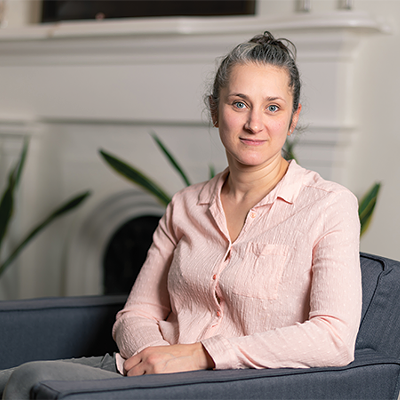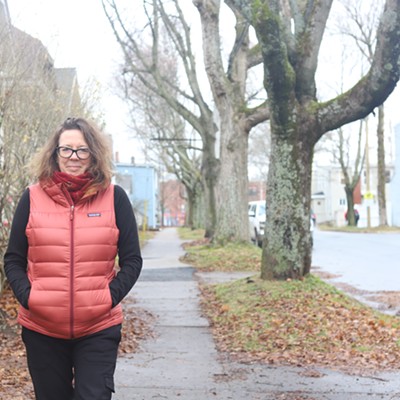Writers are scavengers.
They tear the flesh off family lore, historic events or personal experiences, hunting for inspiration. Sometimes the hunt is pragmatic, but in some rare situations, magic—or perhaps destiny—occurs.
If you believe in magical intervention, you might attribute the conception of Ami McKay’s gorgeous debut novel The Birth House to old-fashioned serendipity. After moving from Chicago to an old farmhouse on the Bay of Fundy with her Canadian partner, McKay discovered that she was pregnant. While searching for a midwife to support a home birth, she learned through neighbours’ stories that her beloved new home used to be a midwife’s community birthing house.
Intrigued, she researched the midwife, Rebecca Steele, who died in 1955. “I felt like Nancy Drew,” McKay says, laughing. It’s a mild spring morning, and the oversized front window of Carlitos cafe on Quinpool radiates with heat, equalling the author’s warm, easy-going manner—hardly the disposition of a best-selling literary diva. In her quest for information, McKay says she interviewed Steele’s adopted daughter, Mary, and her neighbours, most of whom are now in their 80s, many of whom were born in the house.
McKay, who has a graduate degree in musicology, supplemented her interviews with trips to archives and local bookstores, eventually producing a documentary about the house for CBC Radio. The documentary didn’t satisfy her storytelling gene: Over three years, with assistance from the Writers’ Federation mentorship program, she produced the first draft of the fictitious The Birth House.
Through narrative, diary entries, recipes, newspaper clippings and illustrations, The Birth House recounts the life of Dora Rare, a protege of her village’s Acadian midwife Miss Babineau, a mystical character whose knowledge of healing herbs and natural medicine often puts her at odds with the community. Set during the rise of obstetrics at the onset of World War One, Dora battles Doctor Gilbert Thomas, a physician hired by a private insurance company, who represents the future of childbirth—clean and clinical. “When I first started, there were tons of stories about men’s lives, and plenty about WWI, but not a lot of stories of rural women in Nova Scotia, and I wanted to show the importance and the depth of their lives,” says McKay. “I wanted to bring forward the traditions and the myths—it seemed like the thing I was supposed to do.”
In telling her stories, McKay has become entwined in the current fight for midwifery legislation in Nova Scotia, a role she gladly embraces. “I was fired up. Some people say don’t have a platform or a message when you write, but that’s who I am,” she says. “The intention of the book was not to bring the message forward—it was to show how women pull together, build community. It does create a window for conversation, though. After three years, I’m ready for these conversations.”
She animatedly discusses—from the era of The Birth House to post-9/11 hysteria—how the medical industry has attempted to institutionalize the emotional and physical well-being of women. “During that time period, it was across the board how little control women had in their lives. They couldn’t go to a pharmacy to pick up anything,” McKay explains. “This idea of control, being accurate, exact and quick—the rise of obstetrics happened at the same time. The medical community rallied around this idea that they needed to standardize childbirth. Women’s lives are messy and magical and wonderful. It’s hard to standardize us.”
The tale of modern midwifery in Nova Scotia is messy too. Now a well-respected profession obtained through a four-year degree at recognized universities, a midwife is a health professional who provides primary care (sole responsibility) throughout a woman’s pregnancy, and up to six weeks after the birth. In British Columbia, Alberta, Manitoba, Ontario, Quebec and in the Northwest Territories, midwifery is regulated and, with the exception of Alberta, the cost is covered by the provinces. In those provinces, midwives are fully insured and integrated into the health care system, working with physicians and nurses to provide women with informed choice, continuity of care, choice of birthplace and comprehensive clinical care. In Atlantic Canada, women who choose midwifery must pay out of pocket for the service, and midwives are legally unable to provide complete medical attention.
The overwhelming benefits of midwifery aren’t in dispute: Studies have conclusively shown midwife-attended births have lower obstetrical interventions such as Caesarian sections, episiotomies and use of forceps; shorter hospital stays and better breastfeeding rates. It eases burdens on the health care system, especially in rural areas where women might not be able travel to the nearest hospital or have access to a family physician. Most of all, it’s a matter of choice: A woman has the right to choose how to give birth and who is in attendance.
Jan Catano is founder of the Midwifery Coalition of Nova Scotia, a consumer advocacy group that since 1984 has focused on making midwifery a regulated, legalized and insured profession (proceeds from McKay’s Wolfville book launch were donated to MCNS). They work closely with the Association of Nova Scotia Midwifes which, although there is no governing legislation, acts as the provincial professional regulatory organization.
Catano explains that MCNS was formed after a well-publicized 1983 trial in Halifax. A baby, delivered in a home birth by a midwife, was rushed to the hospital with a heart defect so severe the newborn had no hope of survival. The infant did indeed die, and the attending physician in the emergency room pressed charges of criminal negligence, which were eventually dropped. “There was no protection for the mother either, it wasn’t the parents who pressed charges, it was the doctor,” says Catano. “The mother was perfectly happy with the care. Midwives are rarely sued because of the close nature of the relationship. The mother didn’t want this, and there was a risk that she was negligent too.”
In the years following the trial, MCNS and other organizations actively lobbied the provincial government for legislation, coming painfully close many times. In 1993, a task force on midwifery was approved by former Progressive Conservative minister of health, George Moody. Within a week of approval, an election was called and the Conservative government fell, as did the task force. More reports, more lobbying. In May 1999, an interdisciplinary working group on midwifery regulation completed yet another a report calling for legislation, which was accepted by the Liberal minister of health, Jim Smith. He asked the department of health to begin drafting legislation, and even appointed an implementation task force. A week later, another election was called and the provincial government was defeated.
Again, more reports, more lobbying, until last year, when the provincial government’s focus on health care reform spawned renewed interest in midwifery as a key component of maternity primary care. Draft legislation is anticipated by the end of April, and an implementation committee is planned. (When asked whether a potential change in provincial government worries her, Catano sucks in her breath: “Oh, yeah.”)
Although legislation needs to pass public hearings, and priorities could shift, doctor Christine Saulnier, the senior research officer and coordinator for the midwifery and women’s reproductive health programme at the Atlantic Centre of Excellence for Women’s Health, is optimistic. “We’re concerned about the next big step, which is how do we certify midwives and how do we ensure funding comes with the legislation,” she explains. “The main issue is really universal access. If women have to pay, the situation is no different. If we were to legislate without funding, they wouldn’t be able to make a living, or barely.”
She envisions, at a minimum, a two-year process to integrate midwifery into all nine provincial district health authorities. Dalhousie’s faculty of health professions has shown interest in developing its own training program, but Saulnier believes public education is paramount: Women need to know the service is available and that they have decision-making power over their own bodies.
“It has gotten better,” says Saulnier. Catano agrees: In the early 1970s when she was pregnant with her first child, the decision to have a C-section was made between her doctor and her husband. Saulnier continues: “I think that women in Atlantic Canada deserve the same standards of care and same choices that exist in the rest of the country, and in the rest of the world. The evidence is compelling; women need to have the same choices here. It’s not fair.”
Currently, The Birth House hovers near the top of Canadian bestseller lists, encroaching on The Da Vinci Code. The hope from activists is that the book’s popularity will open public discussion, and battle the stigma that midwifery is nothing more than an unclean, hippie whim.
In his February 20 National Post column, Jonathan Kay, in response to his wife’s pregnancy, suggested that women who choose natural childbirth suffer from a “newfound conceit that birthing should be a spiritual event.” Kay found a “doctor friend” to back up his theory: “‘Parents forget how many things can go wrong…Delivering a baby is a major medical procedure. It’s potentially dangerous, and it hurts like hell. Who do you want to be on the receiving end—a trained doctor backed up by modern life-saving machines and painkillers, or some woman with a Guatemalan hat?’”
Although this sort of ignorance might be limited to conservative, uterus-free newspaper columnists, Saulnier isn’t surprised by Kay’s viewpoint. “In terms of the public, I think there are still some preconceptions and myths around midwifery. I think that Ami’s book is interesting in looking at the training of a midwife in the 1900s. There was a perception that it was second-class service, which I still think might be there: It’s the neighbourhood woman and she has no skills. We still need to address what a modern-day midwife is.”
Catano says the more midwifery is written about, the better. “Anything that normalizes it for the vast majority of people is a good thing. Anything that gets the word midwife tripping off people’s tongues is a good thing.”
Ami McKay reads at the Halifax International Writers’ Festival, April 8 at Lord Nelson Hotel, 1515 South Park, 7:30pm, $7.
















